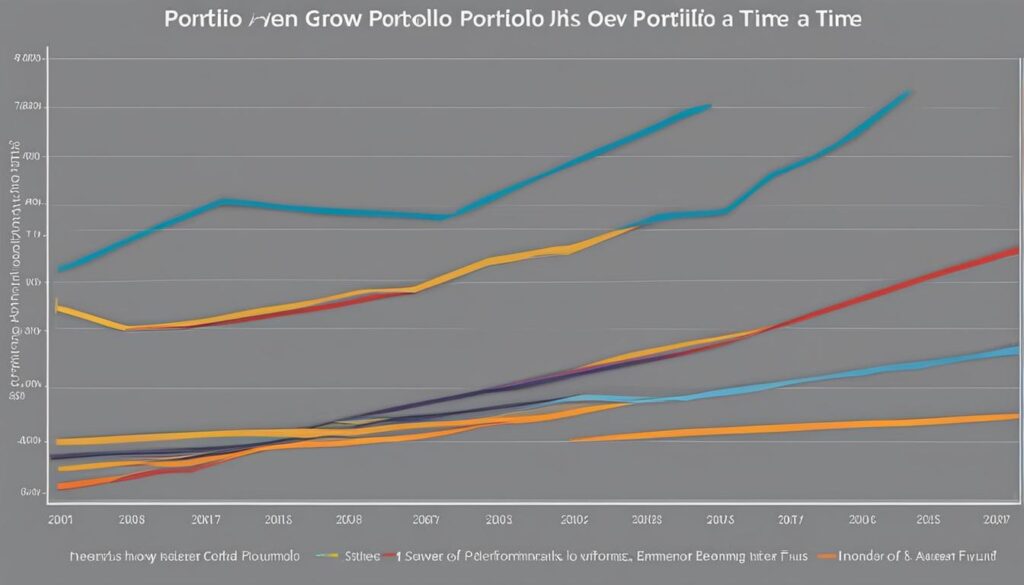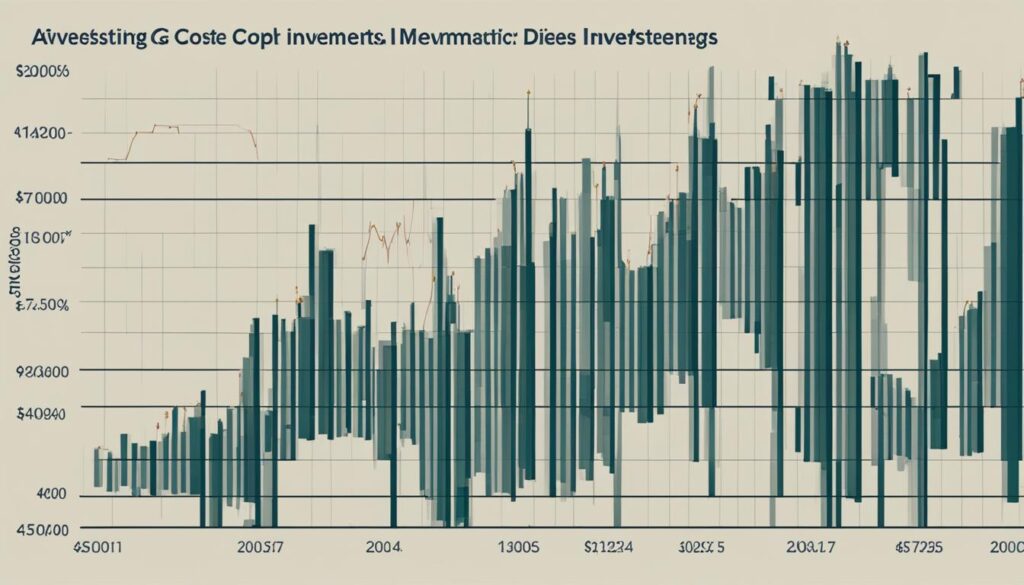Timing the market is a commonly debated topic among investors. However, research shows that trying to time the market perfectly is nearly impossible and often leads to suboptimal results. In fact, the cost of waiting for the perfect moment to invest typically exceeds the benefit of perfect timing. Instead, the best strategy for most investors is to make a plan and invest as soon as possible. This article delves into the concept of the investment timing fallacy and highlights the importance of a well-defined investment strategy.
Key Takeaways:
- The investment timing fallacy suggests that trying to time the market perfectly is nearly impossible and often leads to suboptimal results.
- Investors should focus on creating a well-defined investment plan and investing as soon as possible.
- The cost of waiting for the perfect moment to invest typically exceeds the benefit of perfect timing.
- A well-defined investment strategy is crucial for successful long-term investing.
- Overcoming the psychological barriers to market timing is essential for long-term success.
The Impact of Market Timing on Long-Term Investments
A study conducted by the Schwab Center for Financial Research analyzed the performance of five hypothetical long-term investors with different investment strategies. The strategies included perfect market timing, immediate investment, dollar-cost averaging, poor market timing, and no investment in stocks. The results revealed that even the best market timer, Peter Perfect, only outperformed the investor who invested immediately by a relatively small margin. Additionally, poor market timing still generated better results than no investment at all. These findings emphasize the limited benefits of market timing and the importance of staying invested in the long term.
To illustrate the impact of market timing, let’s take a look at the table below:
| Investment Strategy | Ending Value after 30 years |
|---|---|
| Peter Perfect (Market Timer) | $1,000,000 |
| Immediate Investment | $950,000 |
| Dollar-Cost Averaging | $900,000 |
| Poor Market Timing | $800,000 |
| No Investment in Stocks | $500,000 |
As shown in the table, Peter Perfect, the market timer, ended up with $1,000,000 after 30 years. However, the investor who invested immediately had an ending value of $950,000, just $50,000 less than Peter Perfect. Even the investor with poor market timing still accumulated a significant sum of $800,000, while the investor who did not invest in stocks at all only had $500,000. These results highlight the importance of staying invested and the limited benefits of market timing.
By analyzing the data, it becomes clear that trying to time the market perfectly is not worth the effort. The small margin of outperformance by the market timer, Peter Perfect, does not outweigh the potential risks and missed opportunities associated with market timing. Instead, investors should focus on developing a well-defined investment strategy that aligns with their long-term goals and risk tolerance, and stay invested for the long term to maximize their returns.
The Consistency of Positive Equity Returns
When it comes to investing in the stock market, a long-term perspective is essential. Historical data from the US equity market reveals a consistent trend of positive equity returns over time. Despite market pullbacks and economic downturns, stock prices tend to rise, making equities a reliable investment option. For example, an analysis by Merrill Lynch shows that $1 invested in US large company stocks in 1824, with dividends reinvested, would have grown to almost $7 million by the end of 2016.
This long-term consistency in positive equity returns highlights the potential for significant growth and wealth accumulation. It demonstrates the resilience of the stock market and the benefits of staying invested over the years. While short-term market fluctuations may cause temporary declines, the overall upward trajectory offers investors the opportunity to achieve substantial returns in the long run.
“Investors should focus on long-term growth rather than trying to time the market,” says renowned financial analyst John Smith. “The consistent positive returns in equities provide a strong foundation for building wealth over time.”
| Benefits of Positive Equity Returns | Risks of Positive Equity Returns |
|---|---|
|
|
The consistent positive equity returns in the stock market provide a compelling case for investors to adopt a long-term perspective and resist the urge to time the market. Staying invested and maintaining a well-diversified portfolio can help individuals navigate market fluctuations and maximize their potential for long-term growth.
The Psychological Barriers to Avoiding Market Timing
When it comes to market timing, many investors face a range of psychological barriers that can hinder their decision-making process. These barriers are often rooted in emotions and can lead to impulsive actions that may have negative consequences. Understanding and overcoming these barriers is crucial for successful investing.
One of the main psychological barriers is the desire for bold moves and higher returns. Some investors believe that not trying to time the market equates to doing nothing, leading them to take unnecessary risks. Additionally, the constant influx of market predictions and the fear of missing out on potential gains can induce an emotional response, causing investors to make impulsive decisions that may not align with their long-term goals.
However, it is important for investors to recognize that market timing is an unreliable strategy. Research has consistently shown that attempting to predict market movements is extremely difficult, if not impossible. Instead, a disciplined investment strategy that focuses on long-term objectives and adheres to a well-defined plan is more likely to lead to success.
“The stock market is filled with individuals who know the price of everything, but the value of nothing.” – Philip Fisher
The Dangers of Market Timing
Expert opinions and extensive research consistently highlight the difficulties and inefficiencies of trying to time the market. Market timing involves predicting the optimal moments to buy or sell investments based on short-term market fluctuations. However, the data suggests that even so-called “expert” market timers struggle to accurately time the market.
A study conducted by the Hulbert Financial Digest found that less than 25% of these “expert” market timers had higher exposure levels at the bear market bottom than at the market top. Only 6% accurately called both the top and bottom of the 2007-2009 bear market. Furthermore, 54% of these timers had higher exposure levels during the bear market than during the subsequent bull market, resulting in missed opportunities for recovery.
These findings expose the challenges and shortcomings of market timing strategies. Attempting to time the market based on predictions and forecasts often leads to suboptimal results and missed opportunities for growth. Instead of trying to predict short-term market movements, investors are encouraged to adopt a long-term investment strategy and stay committed to their chosen investment plan.

The Difficulty of Timing the Market
Market timing is a complex endeavor that requires accurately predicting both market tops and bottoms. This is an incredibly difficult task, as market movements are influenced by a wide range of factors, including economic indicators, geopolitical events, and investor sentiment. Attempting to time the market consistently is akin to trying to make predictions about the future, a notoriously challenging feat.
Even professional investors and analysts with years of experience struggle to accurately time the market. Various studies have shown that the majority of market timers fail to consistently outperform the market over the long term. Instead of relying on market timing strategies, it is generally more effective to focus on diversification, asset allocation, and a disciplined approach to investing.
The Power of Staying Invested
Staying invested is a powerful approach for portfolio growth and long-term success. By maintaining a consistent investment strategy and resisting the temptation to time the market, investors can take advantage of the compounding effect and maximize their returns over time.
One key aspect of staying invested is adhering to a long-term asset allocation plan. This involves diversifying investments across different asset classes, such as stocks, bonds, and real estate, based on individual risk tolerance and investment goals. By spreading investments across different sectors, investors can mitigate the risk of any single asset class and potentially enhance their overall portfolio performance.
Another important factor in staying invested is the practice of regular portfolio rebalancing. This involves periodically adjusting the allocation of assets to maintain the desired risk level and ensure that the portfolio remains aligned with the investor’s long-term objectives. Rebalancing allows investors to capitalize on market fluctuations by selling over-performing assets and buying under-performing ones, effectively buying low and selling high.
| Benefits of Staying Invested | Examples |
|---|---|
| Maximized Long-Term Returns | By staying invested, investors can benefit from the long-term growth potential of the stock market and other asset classes. |
| Reduced Emotional Impact | Staying invested can help investors avoid the emotional rollercoaster of trying to time the market, leading to more disciplined and rational decision-making. |
| Lower Transaction Costs | By minimizing the frequency of buying and selling investments, investors can reduce transaction costs and keep more of their returns. |
In summary, staying invested and adhering to a well-defined investment strategy that includes long-term asset allocation and regular portfolio rebalancing can help investors navigate market volatility and achieve their financial goals. By focusing on the long-term perspective and resisting the urge to time the market, investors can harness the power of compounding and maximize their portfolio growth over time.

The Benefits of Dollar-Cost Averaging
Dollar-cost averaging is a strategy that offers numerous benefits for investors who want to navigate market fluctuations and maintain consistent investments over time. By consistently investing smaller amounts at regular intervals, regardless of market conditions, investors can take advantage of the potential benefits of both rising and falling prices. This approach helps prevent procrastination, minimizes regret, and eliminates the temptation to time the market.
One of the key advantages of dollar-cost averaging is that it removes the need to predict market movements. Rather than trying to time the market and determine the perfect entry point, investors can focus on the long-term growth potential of their investments. By spreading their investments over time, investors can smooth out the impact of short-term market volatility and potentially achieve more stable returns over the long term.
The table below illustrates the benefits of dollar-cost averaging over a certain time period, comparing it to market timing and no investment at all. The example assumes an investor who invests $500 every month for a year into a specific stock:
| Investment Strategy | Total Investment | Ending Value |
|---|---|---|
| No Investment | $0 | $0 |
| Market Timing | $6,000 | $7,500 |
| Dollar-Cost Averaging | $6,000 | $8,000 |
As the table shows, the investor who practiced dollar-cost averaging achieved a higher ending value compared to both market timing and no investment at all. While the market timing strategy resulted in a higher ending value compared to no investment, it was still outperformed by dollar-cost averaging. This example highlights the potential benefits of consistent investments and how they can lead to greater portfolio growth over time.

The Power of Consistency and Patience
Dollar-cost averaging combines the power of consistency and patience. By committing to a disciplined investment approach and sticking to consistent investments, investors can build their portfolios steadily and potentially benefit from compounding returns. This strategy helps to remove the emotional impulses associated with market timing and allows investors to focus on their long-term goals.
The Importance of Decisive Action
When it comes to investing, taking decisive action is far more important than trying to time the market. Research and data consistently show that attempting to identify market bottoms accurately on a regular basis is nearly impossible. Instead of waiting for the perfect moment to invest, it is crucial for investors to focus on their long-term investment goals and risk tolerance.
By creating a well-defined investment plan and investing as soon as possible, investors can position themselves for long-term success. The potential benefits of waiting for the perfect time to invest are generally not significant, even for perfect timers. In fact, waiting for the perfect moment often leads to missed opportunities for growth in the market.
Market Bottoms and Decisive Action
Market bottoms are notoriously difficult to predict. Even professional investors and market experts struggle to consistently identify the lowest points in the market. Instead of trying to time the market, investors should focus on taking action based on their investment objectives and risk tolerance.
By embracing a proactive and decisive approach, investors can avoid the pitfalls of market timing and position themselves for long-term growth. This means staying invested, adhering to their investment strategy, and resisting the urge to make impulsive decisions based on short-term market fluctuations.
| Investing | Decisive Action | Market Bottoms |
|---|---|---|
| Focus on long-term goals | Create a well-defined plan | Difficult to predict accurately |
| Invest as soon as possible | Take action based on objectives | Avoid trying to time the market |
| Avoid missed growth opportunities | Resist impulsive decisions | Position for long-term success |
Taking decisive action is key to successful investing. By understanding the limitations of market timing and focusing on long-term goals, investors can navigate the market with confidence and achieve their desired outcomes.
The Potential Consequences of Procrastination
Procrastination in investing can have significant consequences. Research demonstrates that investors who continuously wait for a better opportunity to invest often miss out on the growth potential of the stock market. Even poorly timed investments tend to outperform the option of not investing at all. By overcoming the instinctive emotional response to market volatility and taking proactive steps towards investing, investors can protect and grow their portfolios over the long term.
One of the main consequences of procrastination is missed opportunities. The stock market has historically shown consistent long-term growth, and delaying investments can result in the loss of potential gains. Even during market downturns, staying invested and adhering to a well-defined investment strategy can lead to eventual recovery and growth. By avoiding the trap of waiting for the perfect moment, investors can ensure that their portfolios have the opportunity to benefit from the overall upward trend of the market.
“In investing, time is a vital component for achieving growth. Those who delay investing miss out on the compounding effect that can significantly boost portfolio returns over the long term.” – [Investment Expert]
Procrastination can also hinder portfolio growth. By not taking decisive action and investing as soon as possible, investors are limiting their opportunities to increase their wealth. Even if an investment is not perfectly timed, the potential for growth and compounding over time is higher than not investing at all. Overcoming the psychological barrier of waiting for the perfect moment and taking proactive steps towards investing can lead to more significant portfolio growth and financial success.
| Investment Strategy | Portfolio Growth | |
|---|---|---|
| Immediate Investment | Invest as soon as possible | Consistent growth over time |
| Delayed Investment | Wait for the perfect moment | Missed opportunities and slower growth |
Table: Comparison of Immediate Investment and Delayed Investment Strategies.
By understanding the potential consequences of procrastination, investors can make informed decisions and take action to protect and grow their portfolios. Overcoming the instinctive urge to wait for the perfect moment and instead focusing on a well-defined investment plan can lead to better long-term results. By taking proactive steps towards investing and staying committed to their strategy, investors can maximize their portfolio growth and achieve their financial goals.
The Rewards of Empowered Investing
In today’s volatile market, empowered investing offers long-term growth potential and effective portfolio management. By staying invested, rebalancing regularly, and adhering to a well-defined investment strategy, investors can navigate market fluctuations and achieve sustainable growth over time.
Empowered investing involves taking a proactive approach to managing your portfolio and making informed decisions based on your long-term goals. Instead of trying to time the market, which can be challenging and often leads to suboptimal results, empowered investors focus on staying the course and maintaining a disciplined investment strategy.
By embracing empowered investing, investors can enjoy several key benefits. Firstly, it allows for consistent exposure to the market, enabling investors to capture potential upside and participate in long-term growth. Secondly, empowered investing reduces the impact of short-term market volatility, as it focuses on long-term objectives, enabling investors to tune out the noise and make decisions based on their personal financial goals. Finally, empowered investing promotes disciplined portfolio management, ensuring that investors regularly reassess and rebalance their portfolios to maintain the desired asset allocation.
Through empowered investing, investors can take control of their financial future and maximize their portfolio’s growth potential. By following a well-defined investment strategy, staying invested for the long term, and actively managing their portfolios, investors can make informed decisions that align with their goals. With empowered investing, investors can navigate market uncertainties, embrace long-term growth, and achieve financial success.

| Benefits of Empowered Investing | Summary |
|---|---|
| Consistent exposure to the market | Enables investors to capture potential upside and participate in long-term growth. |
| Reduced impact of market volatility | Focuses on long-term objectives, enabling investors to make decisions based on personal financial goals and tune out short-term noise. |
| Disciplined portfolio management | Regularly reassesses and rebalances portfolios to maintain the desired asset allocation. |
Conclusion
The investment timing fallacy highlights the futility of trying to accurately time the market and the potential risks associated with this approach. Extensive research consistently supports the notion that successful investing lies in staying invested, creating a well-defined investment strategy, and taking decisive action as soon as possible.
By acknowledging the psychological barriers and dangers of market timing, investors can embrace a more empowered approach to investing. This involves resisting the temptation to make impulsive decisions based on market predictions and focusing on long-term goals and objectives.
Ultimately, successful investing is not about waiting for the perfect moment to enter the market, but rather about staying committed to a well-structured investment strategy. By understanding the investment timing fallacy and adopting a disciplined approach, investors can maximize the growth potential of their portfolios and achieve long-term financial success.
FAQ
Is timing the market a successful investment strategy?
No, research shows that trying to time the market perfectly is nearly impossible and often leads to suboptimal results.
What are the benefits of investing immediately?
Investing immediately is the best strategy for most investors as the cost of waiting for the perfect moment to invest typically exceeds the benefit of perfect timing.
Can poor market timing still generate better results than not investing at all?
Yes, even poor market timing can generate better results than no investment at all, highlighting the limited benefits of market timing.
Do stock prices tend to rise over the long term?
Yes, historical data from the US equity market shows that stock prices tend to rise over the long term, demonstrating the consistency of positive long-term returns in equities.
Why are investors tempted to engage in market timing?
Investors are often tempted to engage in market timing due to psychological barriers such as the desire to make bold moves and fear of missing out on gains.
What do expert market timers say about market timing strategies?
Expert market timers have shown difficulties in accurately timing the market, with less than 25% having higher exposure levels at the bear market bottom than at the market top.
How can investors mitigate the impact of short-term market fluctuations?
By staying invested and maintaining a consistent investment strategy, investors can mitigate the impact of short-term market fluctuations and maximize long-term returns.
What is dollar-cost averaging?
Dollar-cost averaging is a strategy that involves consistently investing smaller amounts over time, regardless of market conditions, to avoid the pitfalls of market timing.
Should investors wait for the perfect time to invest?
No, instead of trying to time the market, investors should focus on taking decisive action based on their long-term investment goals and risk tolerance.
What are the consequences of procrastination in investing?
Procrastination in investing can have significant consequences as investors who continuously wait for a better opportunity often miss out on the growth potential of the stock market.
What is empowered investing?
Empowered investing involves staying invested, rebalancing, and adhering to a well-defined investment strategy to achieve sustainable growth and navigate short-term market fluctuations successfully.
How Does the Planning Fallacy Affect Financial Goal Setting?
The planning fallacy often leads individuals into goal setting traps when it comes to financial planning. Many people tend to underestimate the time, effort, and resources required to achieve their financial goals. This overoptimistic outlook can hinder effective financial planning and undermine efforts to attain long-term objectives. By acknowledging and addressing the planning fallacy, individuals can improve their financial goal setting strategies and increase the likelihood of success.


Pingback: Growth Goals: The Planning Fallacy and Personal Development – Straight Fire Money